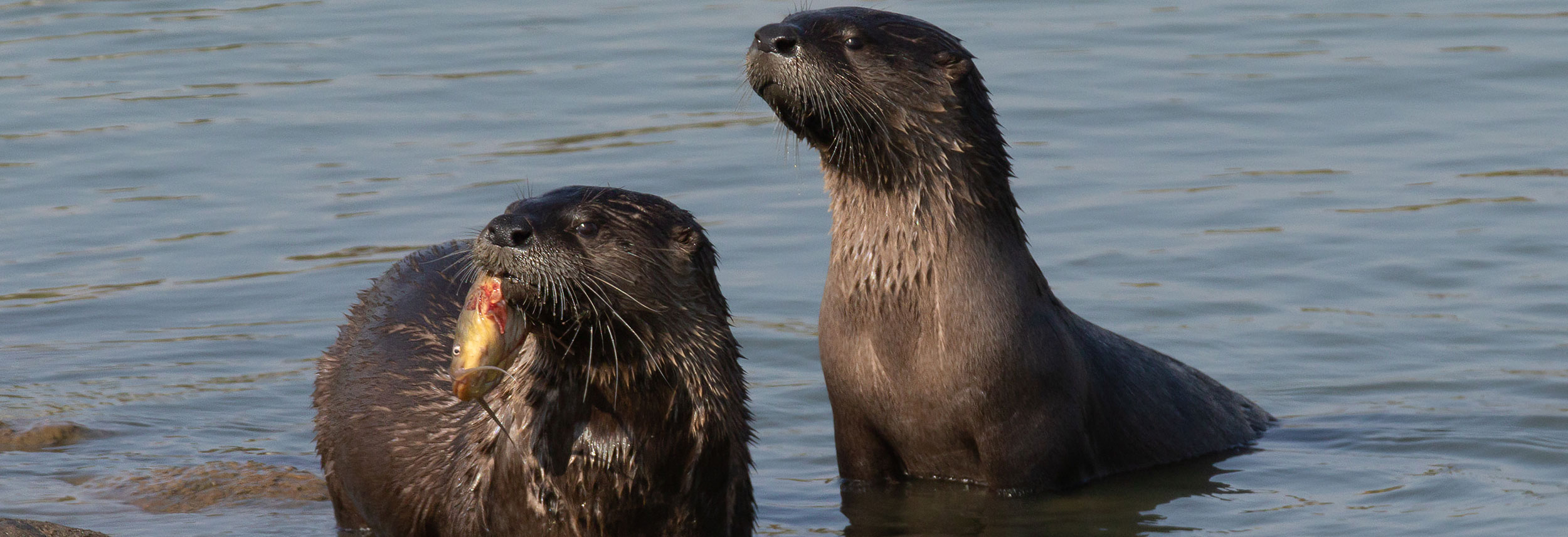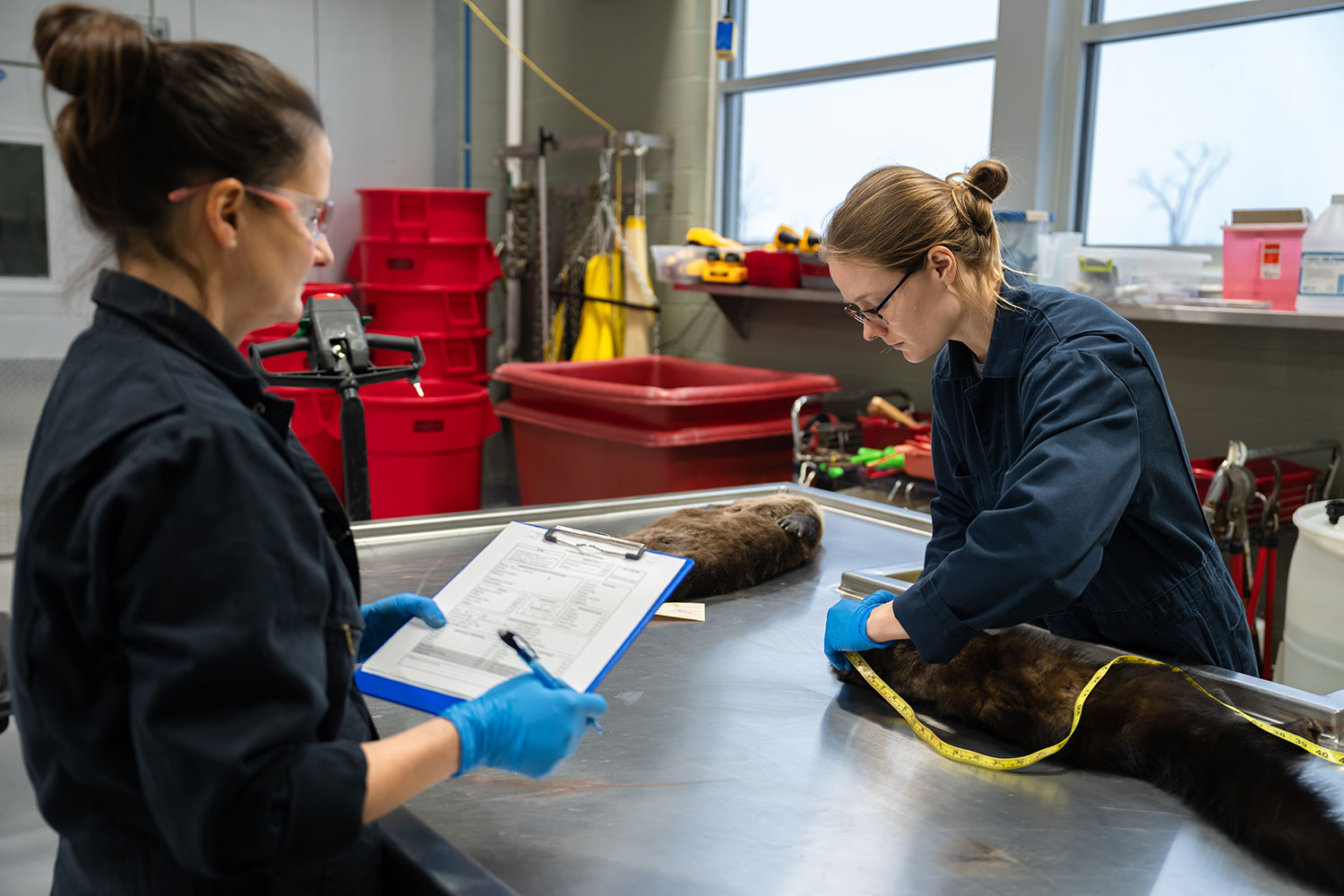
Learning from the Dead
By Ron Wilson
Unlike, say, sharp-tailed grouse that dance on prairie flat spots in spring, providing biologists a decently accurate headcount of those in attendance, many furtive furbearers don’t offer the same, or anywhere near the same, unobstructed glimpses into the status of their populations.
 Stephanie Tucker (right) and Megan Siegl discuss the physical makeup of a mountain lion prior to the necropsy.
Stephanie Tucker (right) and Megan Siegl discuss the physical makeup of a mountain lion prior to the necropsy.
Take mountain lions for instance.
“They have really low densities on the landscape, they have huge home ranges, they’re nocturnal and very secretive even when they’re moving about during the day,” said Stephanie Tucker, North Dakota Game and Fish Department game management section leader. “Which means we can’t drive around and count them or even go up in an airplane and count them. So, we have to come up with other ways to survey the populations and monitor those population trends.
“And that is especially important if we have an open hunting or trapping season on that animal,” she added. “We need some way to monitor those populations and ensure that our hunting and trapping seasons are either having the impact or not having the impact depending on what our population management goals are for that species.”
Game and Fish manages these secretive furbearer species through necropsies, which Tucker explained are autopsies on animals instead of humans. While necropsies are performed for a variety of reasons, to determine an animal’s health or cause of death, for example, the necropsies Tucker and staff do on furbearers usually serve a different purpose.
“Mountain lions, bobcats, river otters and fishers are four of the species of furbearers in North Dakota that we require hunters and trappers to relinquish the carcass to us after the pelt has been removed,” Tucker said, “and we’re just using that necropsy to collect some very basic demographic and reproductive information about the animals so that we can survey them.”
While Tucker and staff can learn a number of things about an animal through a necropsy, what’s vital is to understand if the population of the furbearer on the examination table is increasing or decreasing.
“For my purposes, when creating a population model, there’s really two important pieces of information. We want to know how old the animal is when it died to estimate survival based on that age information,” Tucker said. “And the second thing is we want to find out if it is a female, was she reproductively active in the last year? And if so, how big was that litter that she might have had.”
 Stephanie Tucker inspects the business end of a mountain lion.
Stephanie Tucker inspects the business end of a mountain lion.
In short, Tucker said biologists are trying to determine through information on survival and reproduction if the population is increasing or decreasing. Which is why it’s vital that hunters and trappers help in the effort to collect enough mountain lion, bobcat, river otter and fisher carcasses to create population models to monitor trends.
This information is necessary in assisting wildlife managers in setting furbearer seasons and limits.
“Let’s say what we’re after is to maintain a stable number of animals on the landscape, but our population trend is really increasing,” Tucker said. “Knowing that, we might open up that hunting or trapping season a little bit more. We might allow more animals to be taken the following year. Yet, if the population is trending downward and we don’t want it heading that way, we might back off on our hunting or trapping seasons a little bit to account for that.”
Before biologists cut open animals to see what information can be gleaned from within, they take a handful of size and weight measurements.
“We want to know, in general, what the size and weight of mountain lions are in North Dakota, because that’s useful to managers both in North Dakota and other regions,” Tucker said.
It helps answer whether mountain lions, for instance, are bigger in this region or smaller.
“These measurements help us age the animal a little bit as well,” she said.
To get a better account on the age of the furbearer in question, biologists pull a certain tooth and send it elsewhere for examination.
“All mammals have growth rings on the roots of their teeth. It’s like when you cut a tree down and you can count the really obvious growth rings, which show that it grows at different rates during different times of year,” Tucker said. “The same thing happens to the teeth of mammals. What we do is pull a standardized tooth and send it to a lab in Montana where they section the tooth and stain it so those growth rings really pop under a microscope. Then they count the growth rings to give us a really accurate age.”
While age and reproductive information top the list of what biologists are seeking during these necropsies, they can learn some other things about the animals during these examinations as well.
 Stephanie Tucker (left) and Cami Wight tape and record the measurements of a fisher. The carcass, like those of mountain lions, river otters and bobcats, are provided by hunters and trappers for inspection.
Stephanie Tucker (left) and Cami Wight tape and record the measurements of a fisher. The carcass, like those of mountain lions, river otters and bobcats, are provided by hunters and trappers for inspection.
“We are able to collect a lot of other really useful information, such as diet, size differences between males and females, plus the overall health of the animal when it was taken,” Tucker said. “We also might do some disease surveillance that can have an impact negatively on the population or have the ability to be transmitted to people.”
When focusing on the diet of mountain lions, for example, Tucker said because these predators like to eat porcupines, biologists begin to look for evidence of this by searching for quills in the face, front shoulders and chest area.
“But we’re also going to open up the stomach cavity to look to see what’s in there. Now, they primarily eat deer. And so, that’s typically what we find and what we expect to find in a mountain lion,” she said. “But sometimes we find other unusual things like the already mentioned porcupine, beaver, wild turkey, things that they might encounter because they are opportunistic.”
But each furbearer species is a little bit different.
“Bobcats, for instance, are rabbit specialists. So, we find primarily remains of rabbits in their stomachs and things like that,” Tucker said. “In years of low rabbit numbers on the landscape, we’ll find a lot of voles and mice in a bobcat’s stomach. It just kind of depends on what’s going on at that time in North Dakota with the predator prey cycle. But a lot of species are pretty predictable in what we’re probably going to find in their stomach.”
Without the necropsies, without the cooperation of hunters and trappers providing the carcasses for inspection, wildlife managers would certainly be behind the game.
“This is our critical survey method for these furbearer species,” Tucker said. “Without these animals to necropsy, we would have no other information to adjust our management up or down, depending on what’s going on with the populations on the landscape because we just wouldn’t know.”




